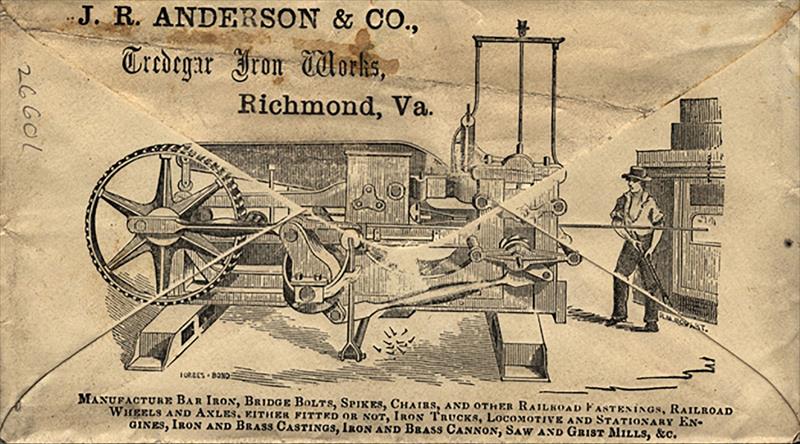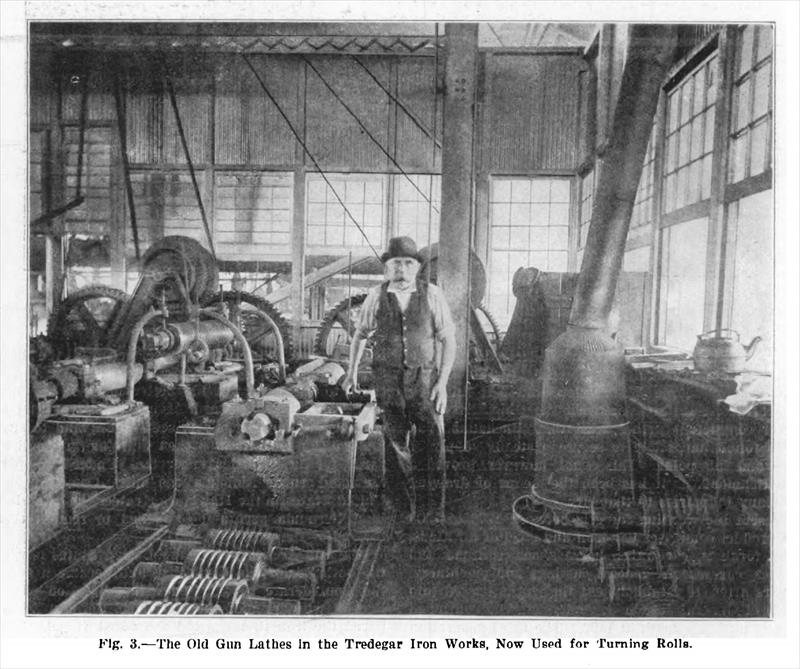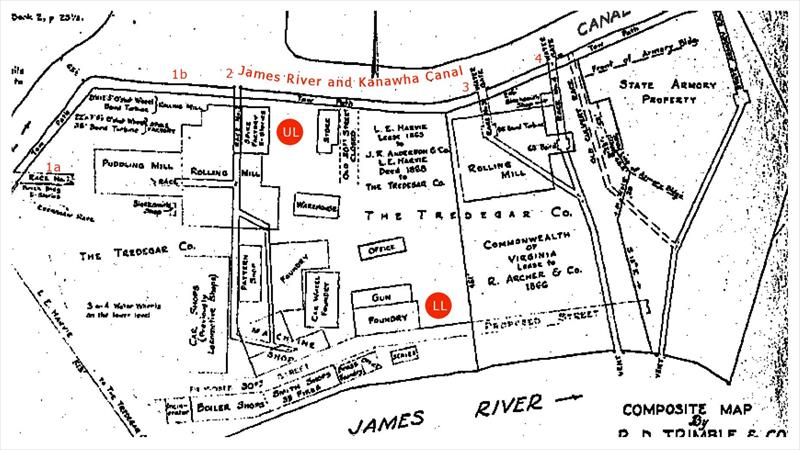Tredegar Iron Works is the best-known of Richmond's many 19th century iron and steel works. Tredegar manufactured stationary and portable steam engines and locomotives in the 1840s and 1850s, sawmills, and woodworking machinery.
Tredegar was founded in 1836 by a group of investors headed by Francis B. Deane, Jr. The group hired Rhys Davies, an experienced mechanical engineer, to construct an iron works. Davies was born in 1795 in Brecknockshire, South Wales, and apprenticed at age 11 to a millwright and patternmaker with Tredegar Iron Co. After serving in the Royal Military Engineers as an artificer (artisan), he worked in France setting up iron works. Davies emigrated to the United States in 1833 and was hired by Deane's company to construct furnaces and rolling mills on the James River in Richmond, and named it for Tredegar in Wales. Unfortunately, Davies died in Richmond Sept. 9, 1838 from stab wounds sustained in a fight with a worker.
In 1841, Tredegar Iron Co. hired 28-year-old civil engineer Joseph Reid Anderson to manage the works. Anderson leased the works in 1846 and purchased it in 1848. On Jan. 1, 1852, Anderson & John Souther founded Tredegar Locomotive Works, and by May were advertising locomotives, steam engines, sugar mills, and horse powers. In early 1855, Anderson sold shares in Tredegar Foundry and Engine Works to Mathew Delaney, Francis T. Glasgow, and William Steptoe. The new partnership was Anderson, Delaney & Co. This partner was announced dissolved effective Mar. 1, 1856, with the name reverting to J. R. Anderson.
The persons named thus far are well-described elsewhere on the internet, with one exception. Mathew Delaney died Aug. 5, 1858, and is buried in Richmond, but no other information about him is known. John Delaney (1802-Nov. 10, 1856) and his son Alexander Delaney also worked at Tredegar during this period. It is likely that Mathew Delaney was from the same family.
On Mar. 28, 1859, Anderson formed a new partnership with John F. Tanner, Robert Archer, and Robert S. Archer, with the name J. R. Anderson & Co. Their 1860 catalog is the only one that is available on the internet. Their products, in the order they appear, were railroad and ship spikes, tie plates, fish plates, car wheels and axles, locomotives, freight cars, car trucks, bolts and nuts, journal boxes, marine steam engines, ordnance, bar iron and billets, spark arresters, portable steam engines, circular saws, sawmills, pumps, shafting, stationary steam engines, Woodworth's planing machine, Noyes' planing machine, portable grist mills, railroad spike machines, fan blowers, cotton screws, cannon shot and shells, gun carriages, cast steel, and hoisting engines.

Undated advertising cover, Mar. 28 1859 or later
The Richmond Enquirer, Oct. 1, 1861 listed owners and management:
The following gentlemen comprise the firm of Anderson & Co.: Joseph R. Anderson, Robert Archer, John F. Tanner, Robert S. Archer. The officers of the Works are as follows: Alexander Delaney, Superintendent; Edward S. Archer, Assistant Superintendent; P. S. Derbyshire, Foreman of the Foundry; John Mofitt, of Machine Shop; J. W. Hercus, of Setting-up Shop; J. W. Curtis, of Finishing Shop; William H. Leach, of Blacksmith Shop; John Reid, of Pattern Shop; Thomas Hays, of Boiler Shop; and Guido Weis, of Carpenter Shop.
During the Civil War, almost all production was military, including artillery pieces, shells, and plate. Joseph R. Anderson was made a Confederate brigadier general, and key employees enlisted but continued to work at Tredegar. Alexander Delaney, for example, was in the 6th Battalion, Local Defense, called the Tredegar Battalion. When it was clear that Richmond would fall to the Union, on Apr. 2, 1865, the Confederates set fire to much of Richmond's business district and the adjacent industry on the river and canals. Anderson posted guards around Tredegar to safeguard it, and Union troops entered the next day. They set up a guard, and foiled a Confederate ruse to have Tredegar burned.
Although Tredegar advertising is scarce, the company had a major fire Oct. 18, 1894, and the description of the damage provides a picture of their post-war manufacturing:
The following is a list of the property destroyed by the fire at the Tredegar works this morning: Car shops, blacksmith shops, paint shed, horse shoe factory, locomotive house, scale house in which were the sixty thousand pound scales, and bolt shop, in which were also stored a number of valuable patterns. Of course the contents of these buildings were totally destroyed. Only the walls of most of the burned buildings are standing, and several of the gutted buildings are deemed in a dangerous condition, and liable to collapse at any time.
A locomotive engine which had been sold to the United States Government to be used in the work of improving the James river was damaged past all use. Twenty box and flat cars were burned. Seven of these were the property of the Richmond & Danville Railroad, two belonged to the Atlantic Coast Line and the balance were owned by the Chesapeake & Ohio. Five more were damaged, but can be repaired. Twenty cars built for use on sugar cane plantations in Cuba were in the car shops ready for shipment. They were all consumed.

Employee George P. Perrini, with 55 years of service, 1907
One distinctive feature of Tredegar Iron Works was its heavy reliance on water power. The company owned rights to water from the adjacent James River & Kanawha Canal, and an elaborate system of races brought water to the facilities. These were drawn by consulting engineers R. D. Trimble & Co. for a lawsuit brought against Tredegar in 1933 by the C. & O. Railway, the canal's owner.

Tredegar millraces, R. D. Trimble & Co., 1933; annotations by Lee Ann Cafferata
The plant had another fire in 1955, and the company moved operations to a suburban location on Castlewood Rd. In 1957 the business was bought by Albemarle Corp., who owned paper mills adjacent to the old plant. Production continued for a few years at the new location. The iron works was noted for its longevity, having survived almost 120 years, and the same was true of its employees. One worked there 65 years, and others had passed 50 years.
Over the years the company used several different names, as listed below along with the dates of the data points we have for that name.
- Tredegar Iron Co. (1840)
- Tredegar Locomotive Works (1852)
- Anderson & Souther (1852)
- Tredegar Foundry & Engine Works (1855)
- Anderson, Delaney & Co. (1855)
- Tredegar Iron Works (1860, 1907)
- J. R. Anderson & Co. (1860)
- Anderson & Co. (1861)
- Tredegar Co. (1867, 1907)
Before the 20th century it was common to make a distinction between the works and the organization that operated them. Thus, as an example, the name "Tredegar Iron Works" co-existed with the name "Tredegar Co."
Information Sources
- Steam Power on the American Farm by Reynold M. Wik, 1953 pages 251 & 254.
- National Park Service: Tredegar Iron Works
- National Park Service: Tredegar Iron Works - Ironmaker to the Confederacy
- Wikipedia: Tredegar Iron Works
- Library of Congress photographs: Tredegar Iron Works
- Virginia Division of Geology and Mineral Resources: Civil War Iron
- Library of Virginia: A Guide To The Tredegar Iron Works Records
- Tredegar Iron Works, Richmond, Virginia: A Study Of Industrial Survival, 1873-1892, by Lee Ann Cafferata, George Mason University, 2016.
- The Bristol Mercury Monmouthshire, South Wales, and West of England Advertiser, Nov. 24, 1838, Pg. 4.
- Richmond Enquirer, Oct. 1, 1861, Pg. 1.
- The Philadelphia Inquirer, Apr. 11, 1865, Pg. 1, 8
- The Wilmington Morning Star, Oct. 19, 1894, Pg. 4.
- The Iron Age. Vol. 80, No. 15, Oct. 17, 1907. Pg. 1057-1059.
- The Bee (Danville, VA), Apr. 19, 1972, Pg. 31.
- The American Cane Mill, ©2010, pgs. 307-308